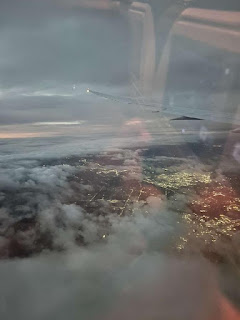Day 12
 |
Sheep on the Road- Some local farmers were in the process of
moving sheep from one paddock to another, so this blocked our road on the was
to Lillburn Station! |
We started the day by leaving Te Anau and heading to
Lillburn Station Limited. On the way, we were a bit delayed because we had to
stop to allow some farmers to move their sheep to a new pasture. This required
them to move the sheep across the road, so students enjoyed snapping pictures of
this event. Lillburn Station is a 2,200-hectare farm owned by the King family.
It has been passed down through generations. At this farm, they have deer that
they raise for velvet and venison, Hereford beef cattle, sheep that they raise
for wool and meat. In terms of crops, they raise forage for their livestock to
graze.
The first stop on the tour was to a haybarn, where we got to
see some cattle grazing in the rough country. The cattle spend their winters
here, and the summers down in the lower, flatter paddocks. The sheep spend
occasional time here in the summer during lambing, but cattle are mostly grazed
in this area. The farm has 400 mature cows with 150 that are registered and 25
sire bulls. All animals on the farm are completely grass fed.
 |
Sheep in the Pasture- As we
were driving through their property, we drove through a paddock of sheep that
ended up fleeing to the gate we needed to get through. |
They keep livestock on a variety of different pastures
depending on the time of year. Their pastures are made up of 15 different grass
mixtures. They have this variety because they want to find the best combination
for their various types of livestock. They also have brassica paddocks, which
for this farm are generally made up of kale or fodder beet. These paddocks are
great to use during the winter months when less grass is being grown.
 |
Woolshed- Students had the
opportunity feel wool and learn a little bit about what consumers are looking
for. |
After the hay barn, the next stop we made was the wool shed.
They have 3,445 mature breeding ewes on the property, along with 70 rams. This
wool shed was very interesting to see, and the students learned lots about the
market for wool in New Zealand. They run a cross of Perriedale and Romney
sheep, and unfortunately, their wool is not a highly sought commodity in New
Zealand. The Merino sheep, which produces a more expensive type of wool, cannot
be raised here because of the wet climate and soft soils. This means that even
if they tried to tap into this market, it would not be beneficial for them or
the sheep.
 |
Deer- Students had the
opportunity to see a stag herd and the herd of the best female deer. |
From the woolshed, we drove through the property back to the deer yard. Deer are relatively easy to farm and require little contact, since the deer are still very skittish, even being somewhat domesticated. Because the deer are so skittish, the farmers don’t manage the deer during fawning season. As far as production, they have 550 hinds, and 80 mature stags. The deer are split into 3 different herds. One stag herd is used to produce velvet and they have a different herd of stag and hinds that are used for venison production.
 |
Velvet Antlers- Before lunch,
friends of the King family brought out some antlers with the velvet still on
them for students to see. |
Their third herd is the top females, which are used to breed replacements for
the velvet herds. Over the past few years, the bloodlines for the deer have
somewhat split, with some being designed for velvet production, while others
are more designed for venison production.
After seeing the deer herds, we made our way back to the
main shed, where we had lunch. Lunch was a fantastic variety of options of beef
and venison patties and sausages, beef patties, lamb chops, and venison so good
that one student said that “It has ruined American venison for me.”
 |
Group Photo- At the end of
the tour, we were able to get a photo of the students with the King family. |
We rounded out the visit by taking a group photo with the
King family in their sale shed. This was a really cool area, and students
enjoyed looking at the different breed and sale catalogs. From there, we left
and headed to Invercargill, where we will be staying for the night.



Comments
Post a Comment